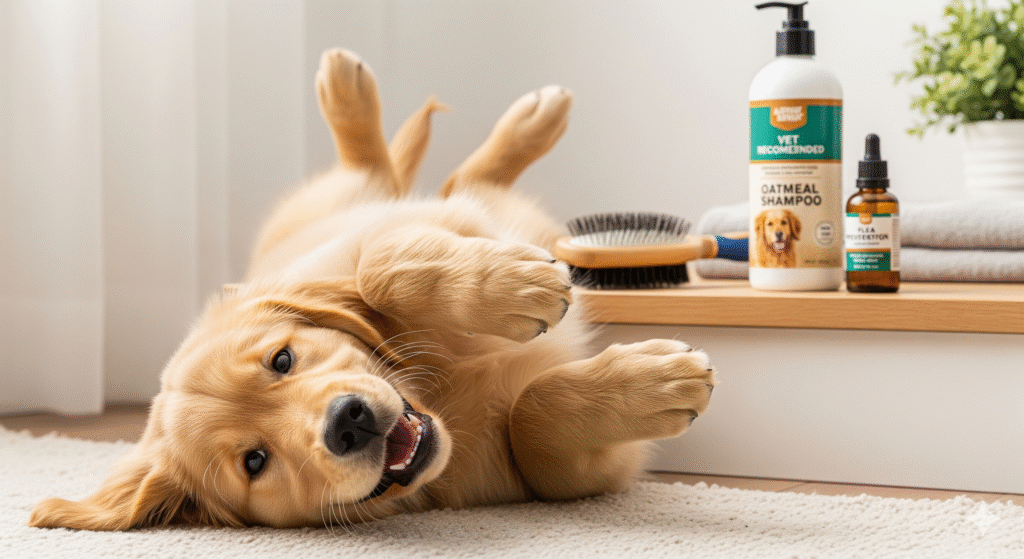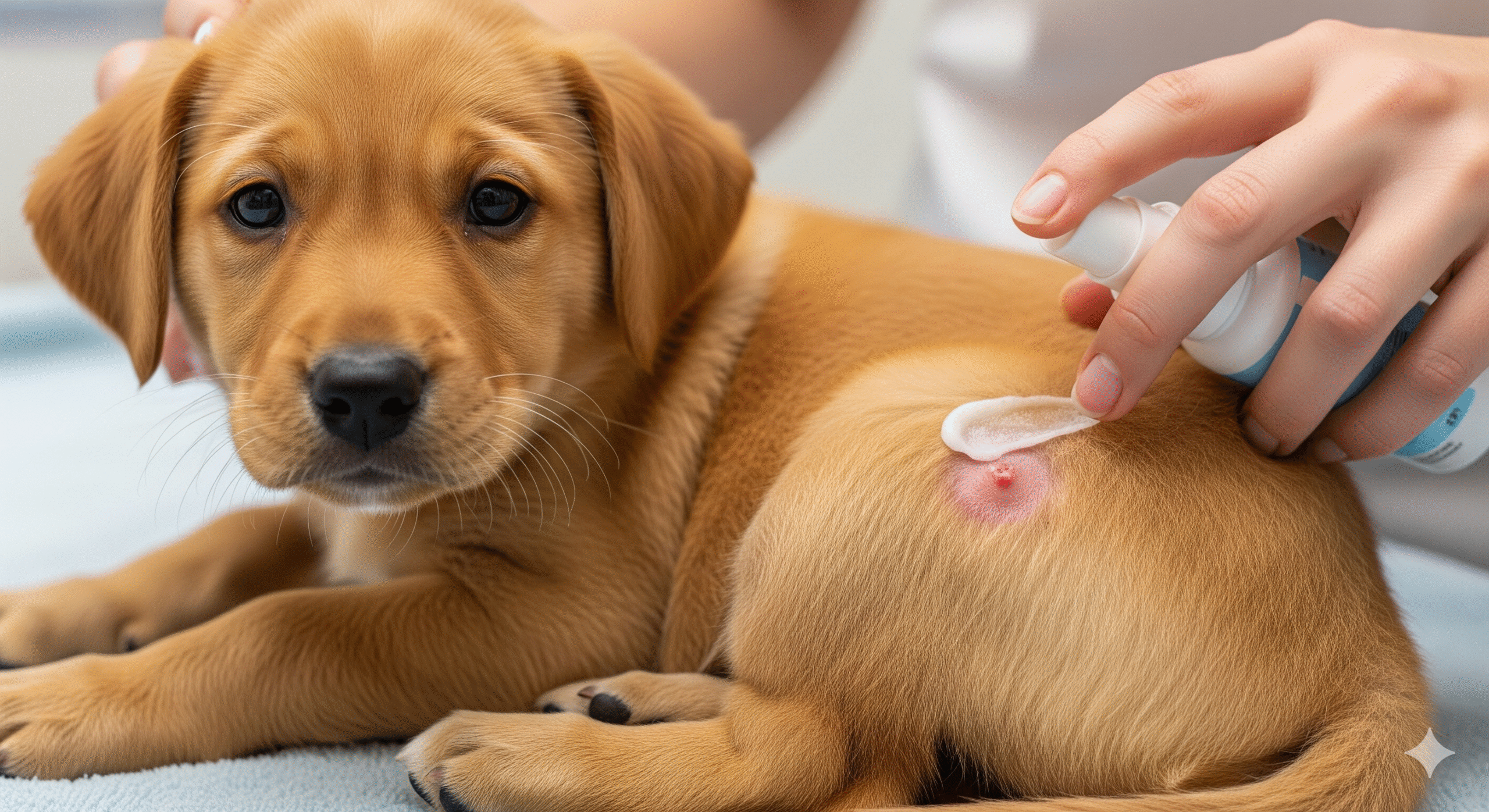One minute your puppy’s skin looks fine, and the next, there’s a angry, red, oozing, and hairless patch that seems to have appeared out of nowhere. Your puppy is obsessed with licking, chewing, or scratching at it, only making it worse. You’re likely dealing with a hot spot, also known as acute moist dermatitis. These painful, localized skin infections can spread with alarming speed and are a common, frustrating issue for puppy owners. Understanding that a hot spot is a symptom, not the primary disease, is the key to effective treatment and prevention.
This guide will help you break the vicious itch-scratch cycle, provide safe first-aid steps, and—most importantly—help you identify and address the underlying cause to prevent these painful sores from coming back.
Here’s what we’ll cover:
✔️ What a hot spot actually is and why they develop so quickly
✔️ The 3-step first aid process for immediate at-home care
✔️ When it’s a vet emergency and what treatments they provide
✔️ The 5 most common underlying causes of hot spots in puppies
✔️ Breed-specific predispositions and risk factors
✔️ Proactive prevention strategies to keep your puppy’s skin healthy
Let’s soothe your puppy’s skin and get them comfortable again.
What is a Hot Spot? The Science Behind the Sore 🔬
A hot spot (acute moist dermatitis) is a superficial skin infection that occurs when normal bacteria on the skin overpopulate and invade a damaged area.
The cycle happens rapidly:
- Initial Itch: Something causes the skin to become itchy (e.g., a flea bite, allergen, or small scratch).
- Self-Trauma: The puppy licks, chews, or scratches the area obsessively.
- Skin Damage: This trauma breaks the skin’s natural barrier, creating a warm, moist, and damaged environment.
- Bacterial Overgrowth: Bacteria (usually Staphylococcus pseudintermedius) that are normally harmless on the skin surface multiply rapidly in this ideal environment.
- Intensified Itching: The bacterial infection causes intense inflammation and itching, which drives the puppy to chew even more, and the cycle continues.
Hot spots can enlarge dramatically in just a few hours.
What Do Hot Spots Look Like? Identifying the Signs 🔍
- Redness: The skin is intensely red and inflamed.
- Moisture and Oozing: The area is wet with pus or a clear discharge.
- Hair Loss: The patch is often completely hairless.
- Pain and Itching: The puppy will react strongly if you touch it and will try incessantly to lick or scratch it.
- Odor: A foul smell may be present due to the bacterial infection.
They most commonly occur on the head, neck, hips, and limbs—anywhere a puppy can easily reach to chew.
Immediate At-Home First Aid (What to Do Now) 🏥
Warning: This can be painful. Proceed gently. If your puppy resists, stop and call your vet.
Step 1: Carefully Trim the Hair ✂️
- Why: This is the most important step. It allows air to reach the wound, drying it out and making it less hospitable to bacteria. It also lets you see the true extent of the damage.
- How: Use blunt-nosed scissors and be extremely careful. Have a helper gently hold and distract the puppy. If the hot spot is large or your puppy won’t tolerate it, let your vet do this.
Step 2: Clean and Disinfect Gently 🧼
- Use a gentle antiseptic: Apply a veterinary-recommended solution like chlorhexidine (Hibiclens) diluted with water (follow package directions) or povidone-iodine (Betadine) on a soft cloth or cotton ball. Avoid hydrogen peroxide or alcohol, as these can damage tissue and delay healing.
- Gently wipe the area to remove debris and discharge. You may need to do this 2-3 times a day.
Step 3: Apply a Soothing Topical Treatment 💊
- Veterinary-recommended sprays: Products like Vetericyn Plus Antimicrobial Hydrogel are excellent. They soothe, clean, and create a protective barrier.
- Avoid thick ointments or creams like Neosporin unless directed by your vet, as they can trap moisture and make the hot spot worse.
Step 4: STOP the Chewing 🚫
- Use an Elizabethan collar (cone) or an inflatable recovery collar. This is non-negotiable. You must break the cycle of self-trauma for healing to begin.
When to See a Veterinarian Immediately 🚨
Do not hesitate to call your vet if:
- The hot spot is very large, deep, or extremely painful.
- Your puppy seems lethargic, feverish, or is not eating.
- The hot spot isn’t improving within 24-48 hours of home care.
- You see multiple hot spots.
- You are unable to safely trim the hair.
Veterinary Treatment May Include:
- Prescription topical sprays or creams with steroids (to reduce inflammation) and antibiotics.
- Oral antibiotics to fight the infection from the inside.
- Oral steroids or antihistamines to control the intense itching and inflammation quickly.
- Pain medication.
- Medicated shampoos.
The Root of the Problem: 5 Common Underlying Causes 🕵️♀️
Treating the hot spot without finding the cause is like mopping up a flooded floor without turning off the tap.
- Flea Allergy Dermatitis: This is the #1 cause. Even a single flea bite can trigger an intense allergic reaction in a sensitive puppy.
- Allergies: Environmental allergies (pollen, dust mites, mold) or food allergies can cause generalized itching that leads to hot spots.
- Ear Infections: A painful ear infection can cause a puppy to scratch at their ear and head, creating hot spots nearby.
- Moisture Trapped in the Coat: Puppies who swim, get bathed frequently, or are out in the rain and not dried properly are at higher risk.
- Boredom or Anxiety: Psychogenic dermatosis—chewing or licking due to stress, boredom, or separation anxiety—can initiate a hot spot.
Breed Predispositions 🐩
Breeds with thick, heavy, or dense coats are more prone to hot spots because moisture gets trapped more easily against the skin. This includes:
- Golden Retrievers
- Labrador Retrievers
- German Shepherds
- Saint Bernards
- Rottweilers
- Huskies
Prevention: How to Stop Hot Spots Before They Start 🛡️
- Strict Flea and Tick Control: Use a vet-recommended preventative year-round.
- Manage Allergies: Work with your vet to identify and manage food or environmental allergies.
- Ensure Proper Grooming: Regular brushing prevents mats, which trap moisture and irritants. Always dry your puppy thoroughly after baths or swimming.
- Address Anxiety: Provide plenty of exercise and mental stimulation. For puppies with anxiety, talk to your vet about solutions.
- Regular Ear Checks: Clean and monitor ears regularly, especially in floppy-eared breeds.
Final Checklist for Managing a Hot Spot ✅
☑️ I have gently trimmed the hair around the area (or scheduled a vet visit to do so).
☑️ I am cleaning the area 2-3 times daily with a gentle antiseptic.
☑️ I am applying a vet-approved soothing spray.
☑️ My puppy is wearing a cone to prevent chewing/licking.
☑️ I have scheduled a vet appointment to address the underlying cause.

While you want your puppy to be clean, over-bathing is a common mistake that strips the natural, protective oils from their skin. This can lead to irritation and flaking. If you’re noticing itchiness or dandruff, our guide to puppy dry skin, with home remedies and shampoos, can help you restore their skin’s moisture.






